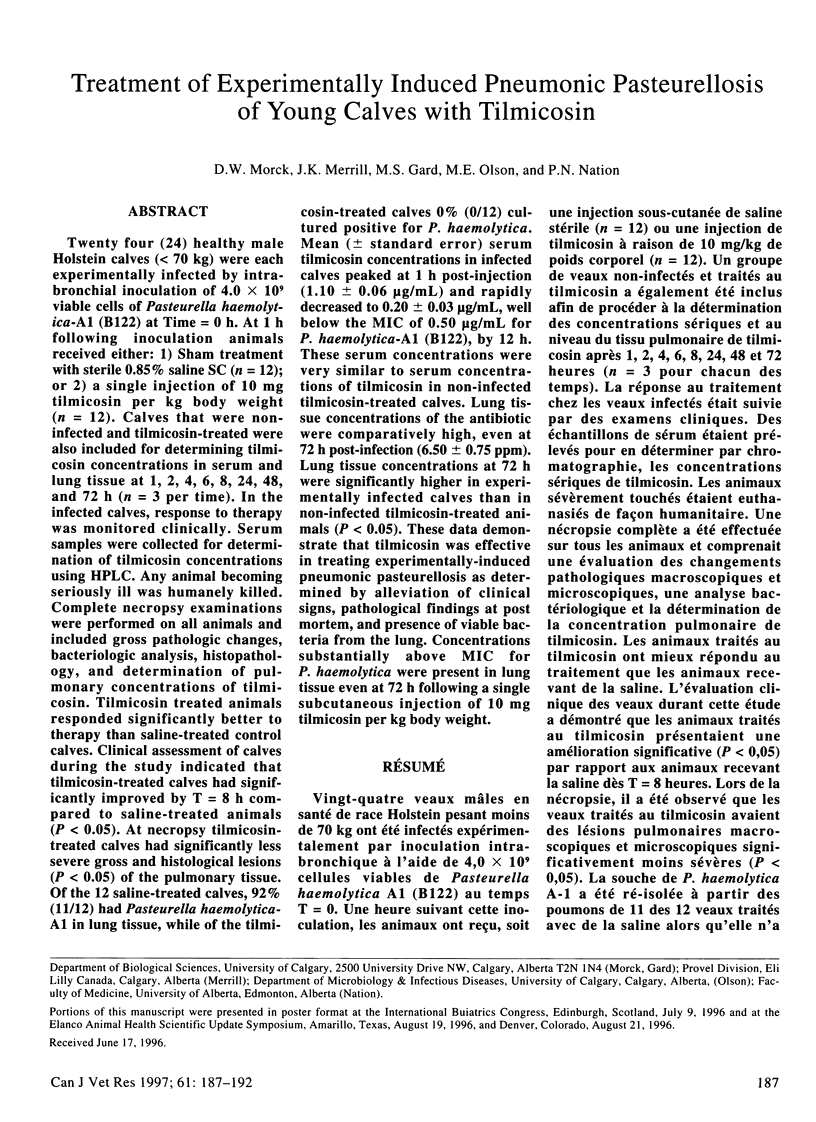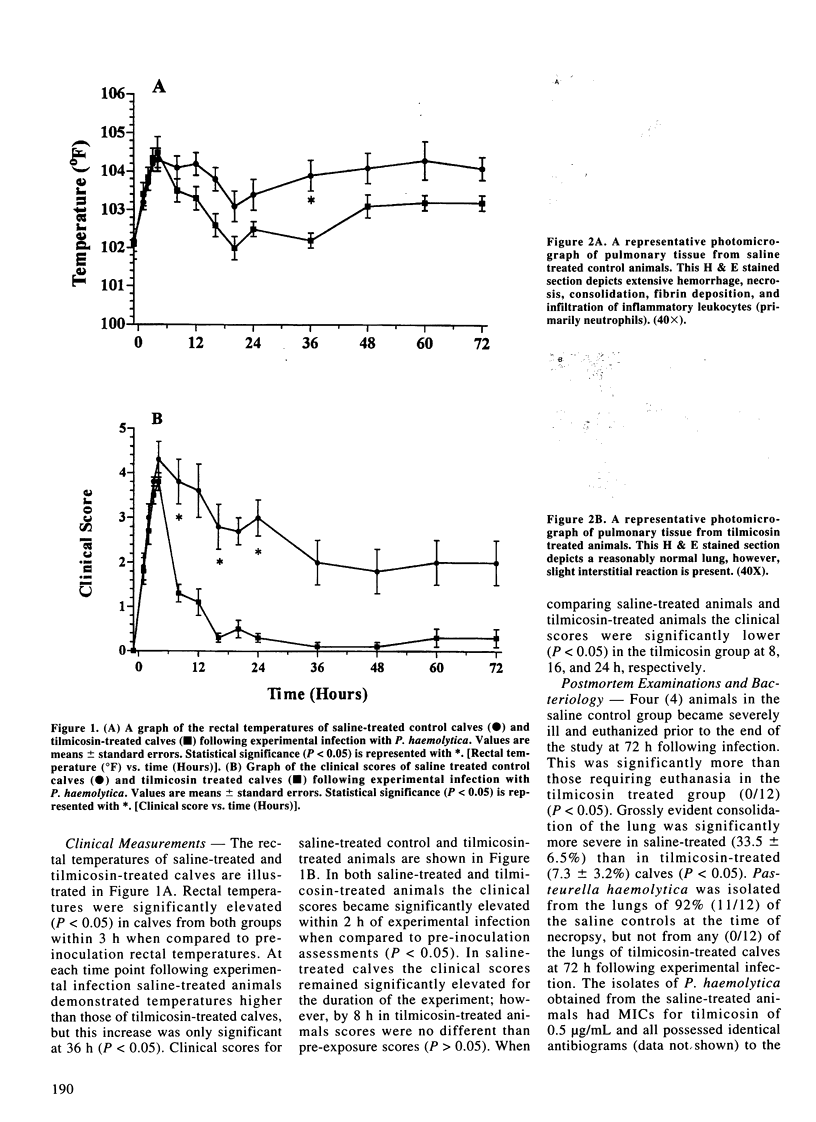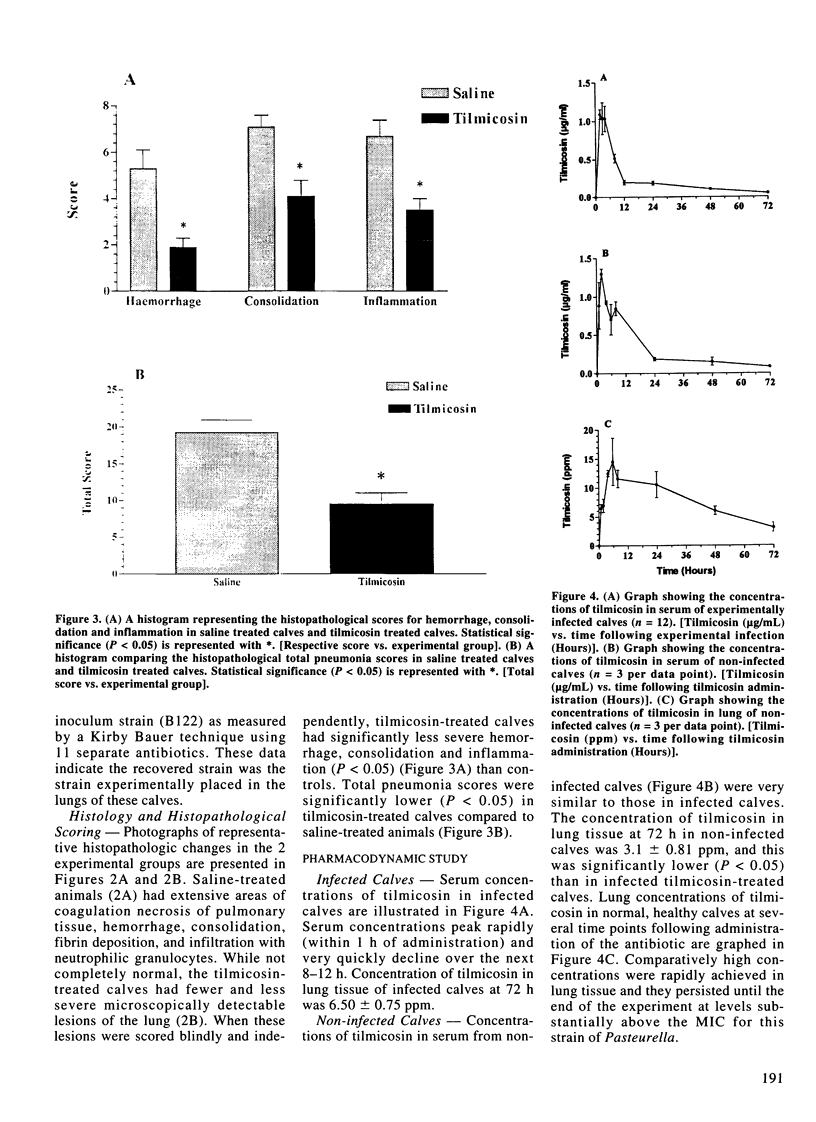Abstract
Twenty four (24) healthy male Holstein calves (< 70 kg) were each experimentally infected by intrabronchial inoculation of 4.0 x 10(9) viable cells of Pasteurella haemolytica-AI (B122) at Time = 0 h. At 1 h following inoculation animals received either: 1) Sham treatment with sterile 0.85% saline SC (n = 12); or 2) a single injection of 10 mg tilmicosin per kg body weight (n = 12). Calves that were non-infected and tilmicosin-treated were also included for determining tilmicosin concentrations in serum and lung tissue at 1, 2, 4, 6, 8, 24, 48, and 72 h (n = 3-per time). In the infected calves, response to therapy was monitored clinically. Serum samples were collected for determination of tilmicosin concentrations using HPLC. Any animal becoming seriously ill was humanely killed. Complete necropsy examinations were performed on all animals and included gross pathologic changes, bacteriologic analysis, histopathology, and determination of pulmonary concentrations of tilmicosin. Tilmicosin treated animals responded significantly better to therapy than saline-treated control calves. Clinical assessment of calves during the study indicated that tilmicosin-treated calves had significantly improved by T = 8 h compared to satine-treated animals (P < 0.05). At necropsy tilmicosin-treated calves had significantly less severe gross and histological lesions (P < 0.05) of the pulmonary tissue. Of the 12 saline-treated calves, 92% (11/12) had Pasteurella haemolytica-A1 in lung tissue, while of the tilmicosin-treated calves 0% (0/12) cultured positive for P. haemolytica. Mean (+/- standard error) serum tilmicosin concentrations in infected calves peaked at 1 h post-injection (1.10 +/- 0.06 micrograms/mL) and rapidly decreased to 0.20 +/- 0.03 microgram/mL, well below the MIC of 0.50 microgram/mL for P. haemolytica-A1 (B122), by 12 h. These serum concentrations were very similar to serum concentrations of tilmicosin in non-infected tilmicosin-treated calves. Lung tissue concentrations of the antibiotic were comparatively high, even at 72 h post-infection (6.50 +/- 0.75 ppm). Lung tissue concentrations at 72 h were significantly higher in experimentally infected calves than in non-infected tilmicosin-treated animals (P < 0.05). These data demonstrate that tilmicosin was effective in treating experimentally-induced pneumonic pasteurellosis as determined by alleviation of clinical signs, pathological findings at post mortem, and presence of viable bacteria from the lung. Concentrations substantially above MIC for P. haemolytica were present in lung tissue even at 72 h following a single subcutaneous injection of 10 mg tilmicosin per kg body weight.
Full text
PDF





Images in this article
Selected References
These references are in PubMed. This may not be the complete list of references from this article.
- Gorham P. E., Carroll L. H., McAskill J. W., Watkins L. E., Ose E. E., Tonkinson L. V., Merrill J. K. Tilmicosin as a single injection treatment for respiratory disease of feedlot cattle. Can Vet J. 1990 Dec;31(12):826–829. [PMC free article] [PubMed] [Google Scholar]
- Gourlay R. N., Thomas L. H., Wyld S. G., Smith C. J. Effect of a new macrolide antibiotic (tilmicosin) on pneumonia experimentally induced in calves by Mycoplasma bovis and Pasteurella haemolytica. Res Vet Sci. 1989 Jul;47(1):84–89. [PubMed] [Google Scholar]
- Kirst H. A., Willard K. E., Debono M., Toth J. E., Truedell B. A., Leeds J. P., Ott J. L., Felty-Duckworth A. M., Counter F. T., Ose E. E. Structure-activity studies of 20-deoxo-20-amino derivatives of tylosin-related macrolides. J Antibiot (Tokyo) 1989 Nov;42(11):1673–1683. doi: 10.7164/antibiotics.42.1673. [DOI] [PubMed] [Google Scholar]
- Laven R., Andrews A. H. Long-acting antibiotic formulations in the treatment of calf pneumonia: a comparative study of tilmicosin and oxytetracycline. Vet Rec. 1991 Aug 10;129(6):109–111. doi: 10.1136/vr.129.6.109. [DOI] [PubMed] [Google Scholar]
- McKay S. G., Morck D. W., Merrill J. K., Olson M. E., Chan S. C., Pap K. M. Use of tilmicosin for treatment of pasteurellosis in rabbits. Am J Vet Res. 1996 Aug;57(8):1180–1184. [PubMed] [Google Scholar]
- Morck D. W., Merrill J. K., Thorlakson B. E., Olson M. E., Tonkinson L. V., Costerton J. W. Prophylactic efficacy of tilmicosin for bovine respiratory tract disease. J Am Vet Med Assoc. 1993 Jan 15;202(2):273–277. [PubMed] [Google Scholar]
- Picavet T., Muylle E., Devriese L. A., Geryl J. Efficacy of tilmicosin in treatment of pulmonary infections in calves. Vet Rec. 1991 Nov 2;129(18):400–403. doi: 10.1136/vr.129.18.400. [DOI] [PubMed] [Google Scholar]
- Thomson R. G. A perspective on respiratory disease in feedlot cattle. Can Vet J. 1980 Jun;21(6):181–185. [PMC free article] [PubMed] [Google Scholar]




